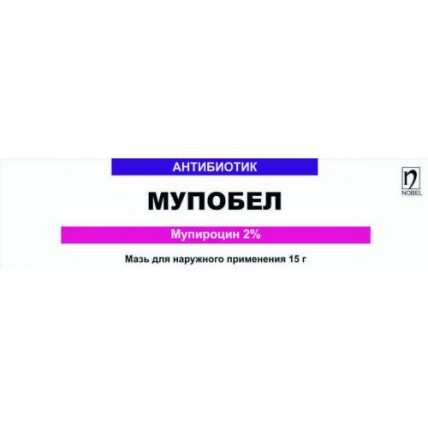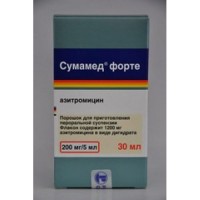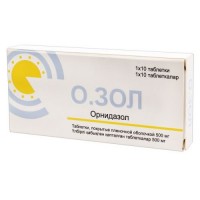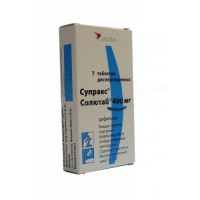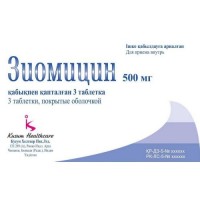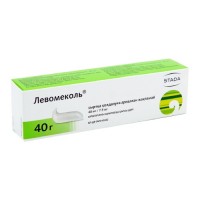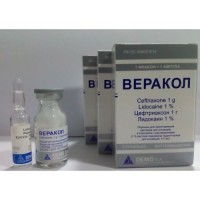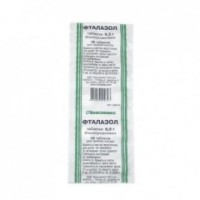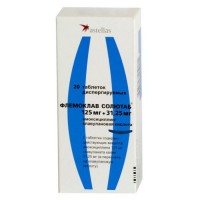Mupobel 2% 15g ointment tube
- $3.50
Out Of Stock
The instruction for medical use of Mupobel Torgovoye medicine a name Mupobel Mezhdunarodnoye the unlicensed name Mupirotsin Lekarstvennaya a form Ointment for external use of 2%, 15 g Structure of 1 g of ointment contains active agent – mupirotsin 20.00 mg excipients: (PEG) 400 polyethyleneglycol, (PEG) 4000R polyethyleneglycol the Description the Uniform ointment of soft consistence of white or almost white color free from foreign inclusions. Pharmacotherapeutic group Antibacterial drugs and antimicrobial drugs for treatment of diseases of skin. Antibacterial drugs for topical administration. Other antibacterial drugs for topical administration. Mupirotsin the ATX D06AX09 Code the Pharmacological Mupirotsin Pharmacokinetics Absorption properties is slightly soaked up through the uninjured skin. Metabolism Mupirotsin is intended only for topical administration, in case of its absorption through the injured skin mupirotsin quickly is metabolized to an inactive metabolite - moniyevy acid. Penetration of a mupirotsin into deep layers of epidermis and dermas increases at traumatic injury of skin and when imposing occlusive bandages. Removal Mupirotsin is quickly brought out of an organism in the form of an inactive metabolite of moniyevy acid by means of the renal mechanism. A pharmacodynamics the action Mechanism Mupobel – the antibiotic of new generation received by fermentation of Pseudomonas fluorescens. Mupobel suppresses protein synthesis and RNA of bacteria by inhibition isoleucyl-transferastvorNK-sintetazy. When using drug in the minimum inhibiting concentration, Mupobel has bacteriostatic action, at increase in concentration – bactericidal. Thanks to this mechanism of action and chemical structure, the drug Mupobel has no cross resistance with other antibiotics and also there is an insignificant risk of development of resistance at use of drug according to recommendations. The following microorganisms are sensitive to the drug Mupobel: In vivo - Staphylococcus aureus (including Methicillinum - resistant strains) - S. epidermidis - β-hemolytic Streptococcus In vitro Gram-positive aerobes: - Staphylococcus aureus (including the strains producing beta lactamazu and Methicillinum - resistant strains) - Staphylococcus epidermidis (including the strains producing beta lactamazu and Methicillinum - resistant strains) Others a coagualase - negative staphylococcus (including Methicillinum - resistant strains) Streptococcus species Gram-negative aerobes: The drug Mupobel is active concerning gram-negative microorganisms, occasionally associated with skin infections: – Haemophilus influenzae – Neisseria gonorrhoeae – Neisseria meningitidis – Moraxella catarrhalis – Pasteurella multocida – Proteus mirabilis – Proteus vulgaris – Enterobacter cloacae – Enterobacter aerogenes – Citrobacter freundii – Bordetella pertussis Susceptible microorganisms: Staphylococcus aureus1 Staphylococcus epidermidis1 Koagulazo-negativnye stafilokokki1 Streptococcus species1 Haemophilus influenzae Neisseria meningitidis Neisseria gonorrhoeae Moraxella catarrhalis Pasteurella multocida. 1 Clinical performance was proved at use within the approved indications Irresponsive microorganisms of Corynebacterium species Enterobacteriaceae Gram-negative sticks of Micrococcus species Anaerobe bacterias the Mechanism of development of resistance the Low level of development of resistance of stafilokokk at the minimum inhibiting concentration of drug from 8 to 256 mkg/ml was revealed as a result of changes of the nature of an izoleytsil of a sintetaza of tRNK. The high level of development of resistance of stafilokokk at the minimum inhibiting concentration of drug of ≥512 mkg/ml is observed in connection with special structure of an izoleytsil of a sintetaza of tRNK. The considerable resistance of gram-negative microorganisms (Enterobacteriaceae) is connected with low degree of passability of drug in a bacterial cell. Indications Topical treatment of primary skin infections of a bacterial etiology: - impetigo - a folliculitis - a furunculosis - an ecthyma Topical treatment of consecutive skin infections of a bacterial etiology: - the infected dermatosis, including eczema - the infected traumatic damages of skin – a graze, stings of insects - the insignificant wounds and burns which are not demanding hospitalization Prevention of bacterial contamination of small wounds, cuts and other tidy wounds and also infection of grazes, insignificant cuts and damages. The route of administration and doses a Small amount of ointment is applied on the damaged site of skin with a thin layer. The bandage can be applied to the processed site. It is impossible to put Mupobel together with other drugs in connection with possible dissolution of a mupirotsin and decrease in its stability that can result in insufficient antibacterial effect. After processing of skin it is necessary to wash up hands for removal of residues of ointment. Any unused residues of drug after the end of treatment have to be destroyed. Adults/children / elderly patsiyentypreparat 2-3 times a day are put. Treatment duration – up to 10 days, depending on the clinical response to the carried-out therapy. Patients with a renal failure Elderly patients: dose adjustment is not required except for cases when the carried-out therapy can lead to absorption of polyethyleneglycol against the background of the existing signs of average or heavy forms of a renal failure. Patients with an abnormal liver function of Dose adjustment it is not required. Side effects the Undesirable phenomena given below are listed depending on anatomo-physiological classification and frequency of occurrence. Frequency of occurrence is defined as follows: very often (≥1/10), it is frequent (≥1/100 and & lt, 1/10), infrequently (≥1/1,000 and & lt, 1/100), is rare (≥1/10,000 and & lt, 1/1,000), is very rare (& lt, 1/10,000, including separate cases), it is unknown (frequency cannot be determined on the basis of the available data). Categories of frequency were created on the basis of 12 clinical trials of drug at 1573 patients and post-marketing data. Often - Infrequently - an itching, an erythema, sensation of burning and dryness in the site of application - skin allergic reactions on mupirotsin or an ointment basis Very seldom - system allergic reactions (generalized rash, a small tortoiseshell, vascular swelled) Contraindications - the known hypersensitivity to a mupirotsin or other components of drug - intranasal and intraocular use Medicinal interactions not to put burning sensation in the site of application of drug along with other drugs. Special instructions In rare instances development of reaction of hypersensitivity or in the presence of serious local irritation, it is necessary to stop immediately carried-out therapy and to wash away drug with further transition to therapy by other drug for treatment of the existing infection. As well as in a case with other antibiotics, prolonged use of drug can lead to growth of insensitive flora. Cases of development of pseudomembranous colitis of various degrees of severity were revealed (from easy to life-threatening) when using antibacterial drugs. Thus, it is necessary to consider the possibility of this diagnosis at development in the patient of diarrhea in time or after use of antibiotics. Though the probability of developing of colitis at external use of a mupirotsin is extremely small, in case of presence of long or long diarrhea and spasms in a stomach, treatment Mupobel has to be immediately cancelled, and the patient is directed for further inspection. Mupobel is not applied at elderly patients with signs of average or heavy forms of a renal failure if there is a probability absorption of large amounts of polyethyleneglycol as the polyethyleneglycol which is a part of drug is removed through kidneys. The drug Mupobel in the form of ointment is not used for: uses in ophthalmology of intranasal use (at newborns and babies) in junctions with a cannula in places of catheterization of the central veins In case of need of intranasal use, use Mupobel in the form of nasal ointment. It is necessary to avoid contact with eyes. At hit in eyes it is necessary to wash carefully them with water before full removal of ointment. Absorption of polyethyleneglycol through open wounds and the injured skin with further removal by means of the renal mechanism is possible. As well as other drugs containing polyethyleneglycol, Mupobel should not be applied in case of the probability of his considerable absorption, especially at patients with a renal failure of average and heavy severity. Pregnancy and the period of a lactation Fertility Data on influence on fertility at the person are absent. Pregnancy there Are no data on use of the drug Mupobel for pregnant women in this connection drug is used only in case the potential advantage exceeds possible risk. The lactation Is not present data on penetration of drug into breast milk. If Mupobel is applied to treatment of nipple cracks, before feeding it is necessary to wash up carefully a breast for removal of residues of ointment. Features of influence of medicine on ability to run the vehicle or potentially dangerous mechanisms the Side effects affecting ability of driving of vehicles and service of the mechanical equipment in the movement were not observed. The overdose Toxicity of the drug Mupobel is very low. In case of inadvertent administration of drug the symptomatic treatment is inside performed. In cases of inadvertent putting ointment in large numbers it is necessary to monitor carefully function of kidneys at patients with a renal failure because of a possibility of development of side effects on polyethyleneglycol. The form of release and packing On 15 g of drug place in the aluminum tubas corked by a plastic cover. On 1 tuba together with the instruction for medical use in the state and Russian languages place in a pack cardboard with the hologram of manufacturing firm. Storage conditions At a temperature not higher than 25 ºС, in the dry, protected from light place. To store out of children's reach! A period of storage 2 years not to apply after an expiration date Prescription status Without prescription Republic of Kazakhstan JSC Nobel Almatinskaya Pharmatsevticheskaya Fabrika Producer, Almaty, Shevchenko St. 162 E. The owner of the registration certificate of JSC Nobel Almatinskaya Pharmatsevticheskaya Fabrika the Republic of Kazakhstan the Address of the organization accepting in the territory of the Republic of Kazakhstan claims from consumers on quality of products (goods): JSC Nobel Almatinskaya Pharmatsevticheskaya Fabrika Republic of Kazakhstan, Almaty, Shevchenko St. 162 E. Phone number: (+7 727) 399-50-50 Fax number: (+7 727) 399-60-60
To develop
To develop
